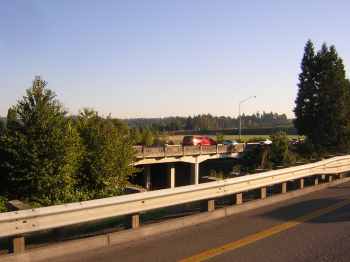
Publisher:
Bonnie King
CONTACT:
Newsroom@Salem-news.com
Advertising:
Adsales@Salem-news.com

~Truth~
~Justice~
~Peace~
TJP
Oct-09-2006 13:52

 TweetFollow @OregonNews
TweetFollow @OregonNews
Bridge Research at Oregon State Allows State to Stretch Funds
Salem-News.comThe bridges of concern, officials say, are found all over the state but are more concentrated in the heavier populated areas of the Willamette Valley and western Oregon. They range from interstate highway to county road bridges.
 Photo by: Tim King |
(CORVALLIS) - An innovative research program in the College of Engineering at Oregon State University has allowed Oregon to stretch its bridge funding dollars by helping the state more accurately evaluate which aging bridges need replacement or repair.
The project developed an engineering evaluation tool called “direct reliability assessment” that may soon gain wider use across the nation, and has been valuable in identifying older concrete bridges that must be replaced or reinforced, as opposed to those that are still safe and have useful life left in them.
This data and the new type of analysis have been used by the Oregon Department of Transportation to dramatically refine the scope of work needed on many failing bridges – a costly problem of huge proportion largely caused by wide use from the 1940s to 1960s of a certain type of bridge design that is now deteriorating in many locations.
Using conventional approaches to bridge analysis and evaluation, the state initially estimated that 365 bridges needed work – 280 to be replaced and 85 repaired. Following a $1.6 million OSU study, the agency now plans to replace just 169 bridges, repair 123 and do no work at all on 73 that were originally considered a problem.
As a result, the OSU study has allowed ODOT to stay within its original estimated budget in the face of rapidly increasing construction material costs. Those costs would have left the department as much as a half-billion dollars short of being able to repair or replace failing bridges on critical freight routes necessary to keeping the Oregon economy strong.
“In engineering you always deal with a range of uncertainties, but the approach we developed provides a way to collect more information about our bridges, reduce that uncertainty and still achieve the same level of safety,” said Chris Higgins, an associate professor of civil engineering at OSU.
“We’ve demonstrated how these new techniques can work, and it’s likely these types of tools will become a standard around the country and may help other states facing similar problems,” he said. “We’re glad we were able to work with ODOT and that the research results have saved money that can now be put to other uses.”
The underlying problem, experts say, was the widespread use in Oregon following World War II of a type of “deck girder” bridge design that was easy to build and kept the use of reinforcing steel, which was expensive, to a necessary minimum. But as traffic volumes and vehicle weight continued to increase over the years, it became clear that the design specifications for these bridges were not adequate, and many began to develop cracks and other problems.
“The use of this type of bridge is a special problem in Oregon,” Higgins said. “We have about 10 times as many of these bridges as Washington does, and about 100 times as many as California, states that transitioned earlier to alternative designs such as those using pre-stressed concrete.”
To address the issue, OSU researchers studied many Oregon bridges in detail, developed a comprehensive data base, and identified 44 test specimens, or girders, that in various combinations could accurately simulate the design variables of almost all the bridges of concern. The samples accurately reflected the various types of span lengths, amount of reinforcement, compression strength, steel location, density and other factors.
Using those girders, engineers then did extensive tests on OSU’s “strong floor” – a large concrete structure that’s essential to this kind of research, built six years ago at a bargain-basement price of about $150,000 with donated materials and construction labor. The facility can test a reinforced concrete beam up to eight feet tall, 24 feet long and weighing 20 tons, applying enormous forces until the specimen literally cracks and collapses.
“Our structural testing laboratory can apply real-world moving loads to girders, a unique capability like no other laboratory in the world,” Higgins said. “With it and our analysis techniques, we now have a system to better assess capacity, address more of the variables and reduce uncertainty.”
Using this approach, the OSU research program showed many Oregon bridges of suspect quality actually had more reserve strength capacity than had been anticipated, and did not need to be replaced. Some could simply be repaired, and others needed no work at all.
The recent research project was supported by the Oregon Department of Transportation and the Federal Highway Administration. A report on its results was reviewed last year by the National Academy of Science and Engineering, and just recently the findings became the basis for revised plans on bridge replacement and repair.
Concerns about the cracking problems have caused load restrictions on some bridges and closed others, and led to passage of a $1.3 billion bond measure by the Oregon legislature.
Articles for October 8, 2006 | Articles for October 9, 2006 | Articles for October 10, 2006

googlec507860f6901db00.html
Salem-News.com:



Terms of Service | Privacy Policy
All comments and messages are approved by people and self promotional links or unacceptable comments are denied.
[Return to Top]
©2025 Salem-News.com. All opinions expressed in this article are those of the author and do not necessarily reflect those of Salem-News.com.